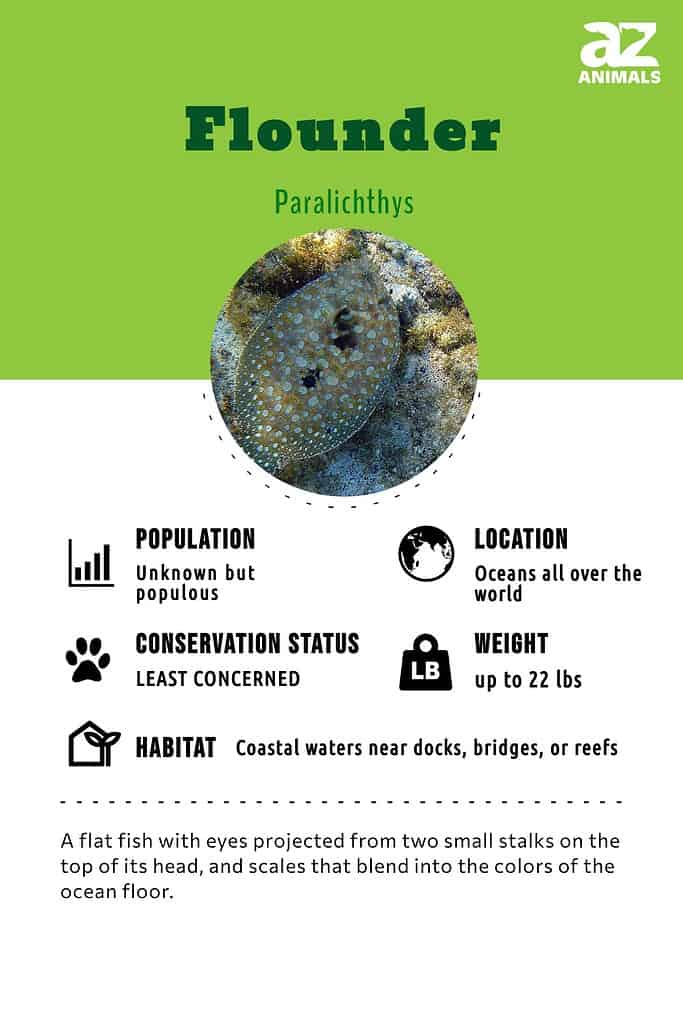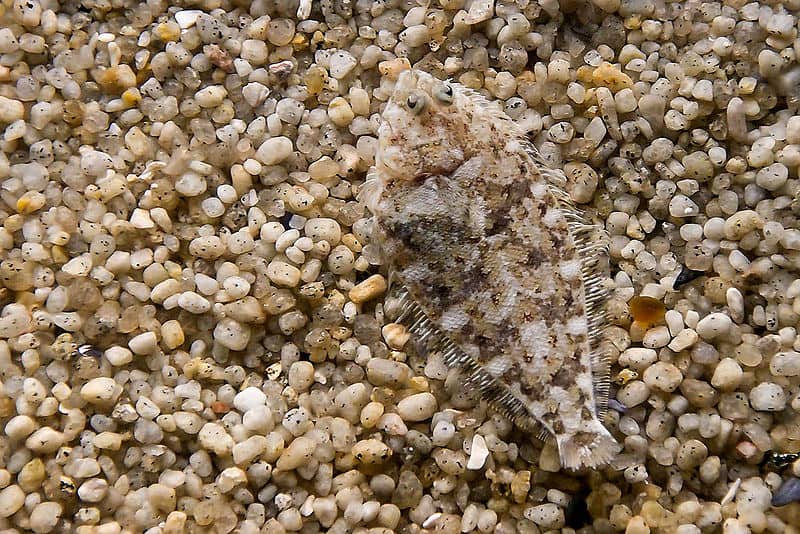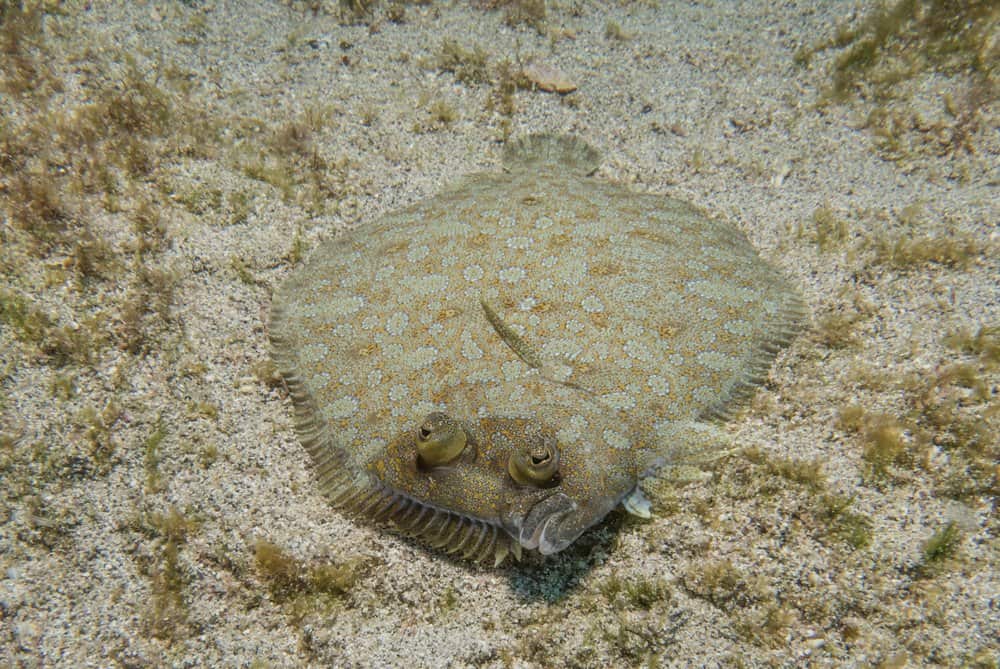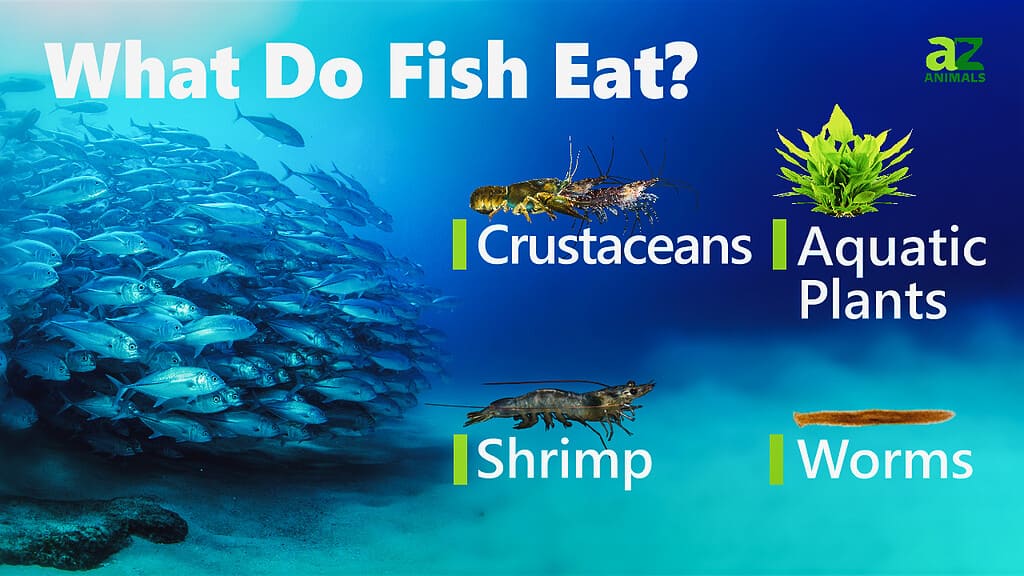Flounder
Paralichthys
The flounder lies motionless on the ground to ambush prey!
Advertisement
Flounder Scientific Classification
- Kingdom
- Animalia
- Phylum
- Chordata
- Class
- Actinopterygii
- Order
- Pleuronectiformes
- Family
- Paralichthyidae
- Genus
- Paralichthys
- Scientific Name
- Paralichthys
Read our Complete Guide to Classification of Animals.
Flounder Conservation Status
Flounder Facts
- Prey
- Shrimp, crabs, and other fish
- Group Behavior
- Solitary
- Fun Fact
- The flounder lies motionless on the ground to ambush prey!
- Estimated Population Size
- Perhaps some 30 million
- Biggest Threat
- Overfishing
- Most Distinctive Feature
- The flat body
- Other Name(s)
- Flatfish
- Gestation Period
- A few weeks
- Optimum pH Level
- 6.5 - 8.0
- Habitat
- Coastal waters near docks, bridges, or reefs
- Predators
- Sharks, eels, and humans
- Diet
- Carnivore
- Favorite Food
- Small Fish
- Type
- Fish
- Common Name
- Flounder
- Slogan
- A flat fish found in the Atlantic and Pacific!
View all of the Flounder images!
With its remarkably thin body, the flounder fish truly lives up to the name of flatfish.
Lying almost motionless along the sandy ocean or seafloor, the flounder fish waits patiently for a tasty meal to come by so it can feed. Its entire lifestyle and physical appearance are oriented around the bottom-dwelling habitat. This is an incredible display of evolutionary ingenuity. But due to its popularity as a cuisine, some species of flounder are in danger of population depletion.

5 Incredible Flounder Fish Facts!
- The technical term for the type of bottom-dwelling marine animal is a demersal fish.
- Some species of flounders are nicknamed the chameleons of the sea due to their ability to change colors as a means of blending in with the environment.
- The flounder fish resembles a typical fish upon birth. A few weeks into its life, it undergoes a profound metamorphosis to transform into a flatfish.
- The flounder fish probably evolved more than 50 million years ago. One fossil from that period demonstrates that some species of flatfish had already evolved an eye on the top of the head.
- As a cuisine, flounder fish is commonly broiled or grilled.
Scientific Name
The term flounder fish is not a true scientific name. This has often inspired quite a lot of confusion among people. Instead, it refers to many different species of flatfish that are part of four distinct families: Achiropsettidae, Pleuronectidae, Paralichthyidae, and Bothidae. All of these families are classified within the order Pleuronectiformes. However, not every member of this order is a flounder fish, because it also includes the dabs, brills, soles, and others. Together these creatures belong to the class of ray-finned fish known as the Actinopterygii.

There are hundreds of species of flatfish – with flounder generally divided into right-eyed and left-eyed families.
©Moondigger, CC BY-SA 2.5, via Wikimedia Commons – License
Species
The flounder fish is generally divided into right-eyed and left-eyed families. The right-eyed family of Pleuronectidae contains some 100 different species. The left-eyed families of Bothidae and Paralichthyidae contain approximately 240 species. The fourth family, Achiropsettidae, has only a few species in it. Here are just a few examples of common flounder species:
- European Flounder Fish: This species occupies a large stretch of territory between the coasts of North Africa in the west, the Black Sea in the east, and the Baltic Sea in the north. This species is so popular as a source of food that it was also introduced to the waters of North America. The body is olive green or pale brown and has an almost diamond shape with the fins included.
- Summer Flounder fish: This species occupies the Atlantic coast of the United States and Canada. It has a dark gray or brown color and rounded fins.
- Dusky Flounder fish: Measuring up to 12 inches, this species has a very long appearance and features tan or brown scales. It resides in a stretch of water between the Gulf of Mexico and the Yucatan Peninsula.
- Winter Flounder fish: Also known as black back, this flounder is a right-eyed flatfish native to the coastal waters of the western north Atlantic coast – from Labrador, Canada to Georgia, United States.
- Peacock Flounder fish: Also known as the flowery flounder, this flounder is blue, pink and yellow like the sands of the shallow waters of the Indo-Pacific where it resides.
- European Plaice: This right-eyed flat fish is known for its sweet and mild flavor with a firm yet juicy texture. It inhabits the muddy bottoms of the European shelf from the Barents Sea to the Iberian peninsula and around Iceland.
- Arrowtooth Flounder fish: This is the most common fish in the Gulf of Alaska and can be caught as far south as Santa Rosa Island, California. It is named for its menacing set of sharp, arrow-like teeth.
- Olive Flounder fish: This rare flounder is also called Korean halibut, Korean flatfish or Japanese flatfish. It is a large-tooth flounder native to the North-western Pacific ocean and has been popularized by the game, “Animal Crossing.”
- Atlantic Halibut: These flatfish are now endangered due to overfishing. They live on sand, gravel, or clay ocean bottoms at depths of between 50 and 2,000 miles. They are found all around the North Atlantic, including around Greenland and Virginia in the west and Iceland and Europe in the east.
- Starry Flounder fish: Also known as the grindstone, emery wheel, and long-nosed flounder, this common fish is found around the North Pacific.

Just as flounder started out as regular fish 65 million years ago before they evolved – they start life the same way today.
©Gaurav Ruke/Shutterstock.com
Evolution
Flatfish in the flounder family are the most asymmetric animals on the planet – and, believe it or not, they weren’t born that way. They start their lives as normal little fish with swim bladders and eyes on either side of their head before they transform into their strange Picasso fish adult form. In a snapshot of evolution, their eyes shift to the top, their swim bladders shrink and their fins become almost useless in a matter of weeks. They begin life as lively little fish before they sink to the bottom to “flounder around” on the bottom of the ocean floor.
All of this strange morphology started about 65 million years ago – and within three million years their evolution was largely complete. Three million years, in evolutionary time, is a blink of an eye. Flatfish species are so dissimilar that it was almost impossible for scientists to track the degree of integration between different regions of the skull across the 65 million year history of flatfishes and their relatives without the creation of complex mathematical models. They found that in flatfishes, the evolution of asymmetry involved changes all across the skull. As the eye migrated – other changes occurred and it became additive.
There is still no explanation for why flatfishes like flounders changed so rapidly and drastically, almost violently – and fish like stingrays just gradually went flat. Sometimes the weirdness of nature is the most amazing thing about it.

Flounders are flat with two big eyes projected from small stalks on the same side of the head.
©Becky Gill/Shutterstock.com
Appearance
The flounder has an unusually flat appearance that’s well-suited for its bottom-dwelling lifestyle. To see everything above it, the flounder has two big round eyes projected from small stalks on the same side of the head. These eyes also can move independently of each other.
The typical flounder specimen measures somewhere between five and 25 inches in length (the larger ever recorded was some 37 inches) and up to 22 pounds in weight. This doesn’t quite capture its true size, however, since the flounder has a massive surface area thanks to its round or oval body.
The flounder’s scales act as camouflage which makes it difficult for both predators and prey to detect it against the muddy or sandy ocean bottom. Some species can actively change their color to blend in with the seabed. This has the dual purpose of also signaling the emotional state of the fish. For instance, a pale color may be a sign that the creature feels threatened.
The flounder comes in a huge range of different colors and patterns, depending on the composition of the sediment in which it resides. The slate of orange, brown, green, white, or tan colors is normal.

Flounders can perfectly camouflage themselves on the seafloor.
©Dark jedi requiem – Public Domain
Distribution, Population, and Habitat
The flounder dwells at the bottom of oceans and seas near docks, bridges, and coral reefs. Its main areas of occupancy include the tropical and temperate waters along the coasts of Europe, North America, Africa, and Asia. Some species also reside much farther north near the Arctic.
It is estimated that some 30 million flounders are still alive across the entire world’s oceans, but pollution, habitat change, and overfishing in the 20th and 21st centuries have depleted some stocks. For many species of flounder, there is not enough data to fully estimate their conservation status. But when data is known, the vast majority of species appear to be in good health.
The conservation tracker IUCN Red List believes that they are of least concern. However, the continued depletion of fish stocks may threaten many species in the future.
In the United States, the National Oceanic and Atmospheric Administration is the main governmental body in charge of carefully managing flounder numbers. The administration uses scientific data to determine how much of the flounder population can be harvested for the following year, and then it allocates resources accordingly between commercial and recreational catches to ensure that enough stocks are present to repopulate the waters.
Diet

Predators and Prey
The flounder fish is primarily a nocturnal carnivore that thrives on a diet of shrimp, crabs, and other fish. Smaller species may consume worms and plankton as well. The exact composition of the diet varies quite a bit by location and species. The flounder is an ambush predator that lies motionless on the ocean or sea floor, blending in with the environmental surroundings, and then quickly snaps up the unsuspecting prey with its sharp teeth.
Because of its relatively large size, the flounder has only a few natural predators such as sharks, eels, and humans. Camouflage offers the best means of protection. When exposed, however, it is very vulnerable to larger predators due to the lack of other natural defenses.

Flounders breed during the warmer months when food is plentiful.
©Porco_Rosso/Shutterstock.com
Reproduction and Lifespan
The flounder’s breeding season usually takes place during the warmer months. The female will release more than 100,000 (and sometimes millions of) eggs from her body, and the male will release his sperm to fertilize them. After a few weeks, the young fry will hatch from the eggs. The spawning is usually timed perfectly with the most productive and bountiful season of the year for food.
At birth, the flounder fish looks like a typical fish. It is born with a standard symmetrical appearance with eyes located on both sides of its head and also swims around the ocean like a fish.
After a few days of this, the flounder undergoes significant physical changes in which the body begins to flatten out, the swimming bladder (which provides buoyancy) disappears, and one eye begins to migrate to the other side of the fish. Once it has fully developed, the flounder tends to live some three to 10 years in the wild.

Flounder is caught, cooked and enjoyed in delicious dishes all over the world.
©Michele Ursi/Shutterstock.com
Fishing and Cooking
Captured for both recreational and commercial purposes, the flounder is one of the most popular deep-sea fishes to eat around the world. It is commonly fried, broiled, or grilled, but it is cooked in so many different ways and served with so many different foods that the variety is truly staggering. The mild taste goes along well with all kinds of sauces, herbs, spices, vegetables, and cheeses.
View all 91 animals that start with FFlounder FAQs (Frequently Asked Questions)
What eats the flounder?
The flounder is a very common prey item for sharks, eels, and humans.
Where do flounder live?
Flounders tend to live at the bottom of the sea bed in coastal regions near manmade structures such as docks and bridges and natural structures such as coral reefs.
Is the flounder a good fish to eat?
The flounder are known to contain lean, high-quality meat with low-fat content (except for healthy omega-3 fats) and high protein content. Studies suggest that it may help lower the risk of heart disease.
What does flounder taste like?
The flounder has a sweet but subtle taste that’s complemented by a flaky and crumbling texture. It is commonly broiled or grilled.
What is the difference between halibut and flounder?
The difference between a flounder and halibut is a source of confusion for many people. Simply put, the halibut is a member of the flatfish family Pleuronectidae. This actually makes it one of the types of flounder. But compared to the average flounder species, the halibut is larger in size and lives farther north as far as Alaska.
Are Flounders herbivores, carnivores, or omnivores?
Flounders are Carnivores, meaning they eat other animals.
What Kingdom do Flounders belong to?
Flounders belong to the Kingdom Animalia.
What class do Flounders belong to?
Flounders belong to the class Actinopterygii.
What phylum to Flounders belong to?
Flounders belong to the phylum Chordata.
What family do Flounders belong to?
Flounders belong to the family Paralichthyidae.
What order do Flounder belong to?
Flounder belong to the order Pleuronectiformes.
What genus do Flounders belong to?
Flounders belong to the genus Paralichthys.
What type of covering do Flounder have?
Flounder are covered in Scales.
What is an interesting fact about Flounders?
Flounders are a flat fish found in the Atlantic and Pacific!
What is the scientific name for the Flounder?
The scientific name for the Flounder is Paralichthys.
What is a distinguishing feature of the Flounder?
Flounder have flat bodies.
What is the lifespan of a Flounder?
Flounders can live for 3 to 10 years on average.
What is the biggest threat to the Flounder?
The biggest threat to the Flounder is overfishing.
What is the optimal pH for a Flounder?
The optimal pH for a Flounder is between 6.5 and 8.0.
What is another name for the Flounder?
The Flounder is also called the flatfish.
How many Flounders are left in the world?
There are around 30 million Flounders left in the world.
How do Flounders have babies?
Flounders lay eggs.
What is the difference between flounder and codfish?
The main differences between cod and flounder are their size, appearance, hunting methods, and reproduction strategy.
What is the difference between tilapia and flounder?
The key differences between flounder and tilapia are their classification, habitat, appearance, diet, and their use in aquaculture and cuisine. These fishes are part of separate orders and families. They live in unique habitats and have individual features and diets that are well adapted for them.
What are the differences between haddocks and flounders?
The differences between haddocks and flounders are appearance, size, diet, distribution, predators, reproduction, and lifespan.
Thank you for reading! Have some feedback for us? Contact the AZ Animals editorial team.
Sources
- David Burnie, Dorling Kindersley (2011) Animal, The Definitive Visual Guide To The World's Wildlife
- Tom Jackson, Lorenz Books (2007) The World Encyclopedia Of Animals
- David Burnie, Kingfisher (2011) The Kingfisher Animal Encyclopedia
- Richard Mackay, University of California Press (2009) The Atlas Of Endangered Species
- David Burnie, Dorling Kindersley (2008) Illustrated Encyclopedia Of Animals
- Dorling Kindersley (2006) Dorling Kindersley Encyclopedia Of Animals
- Britannica, Available here: https://www.britannica.com/animal/flounder
- Soft Schools, Available here: https://www.softschools.com/facts/animals/flounder_facts/1400/
- Fishing Booker, Available here: https://fishingbooker.com/blog/halibut-vs-flounder-all-you-need-to-know/

















